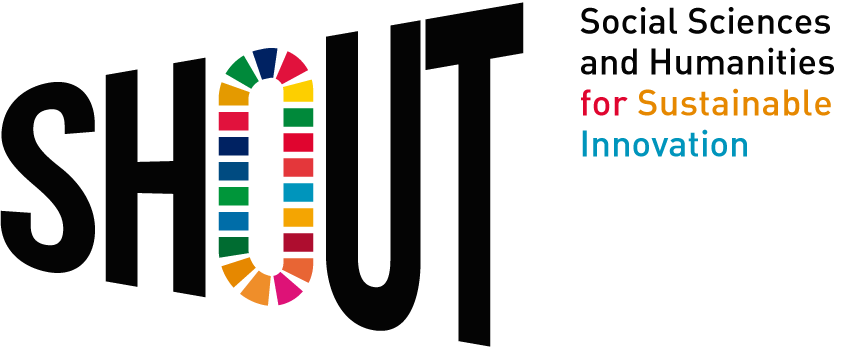Stages of PAR
This is an overview of the stages of a Participatory Action Research. The stages are analyzed in detail in the following slides.
1. Choosing an issue.
2. Choose participants and identify the research team
3. Find funding
4. Choose research methodology
5. Data Analysis and interpretation
6. Presentation of results
7.Take action
8. Evaluate
Stage 1
What is the goal?
- At this stage individuals or groups identify an issue that they are interested to investigate.
- Researchers should have experience on the specific topic.
- Research questions are formulated.
- The research question should reflect the community’s goals; what they want to change.
Stage 2
Who will be involved?
- At this stage the individuals that selected the issue that needs to be studied, decide whether they have the necessary knowledge to put through the research or they need to recruit some experts.
- At this stage they can also decide if they want to partner with community organizations, that can support your study.
- The roles of the team members are identified.
Stage 3
Where funds can be found?
- At this stage the individuals that selected the issue that needs to be studied, decide whether they have the necessary knowledge to put through the research or they need to recruit some experts.
- At t
- At this stage the team can reach out to organizations that offer grants in order to obtain funding.
- The team submits a proposal to obtain the funding.
- A proposal usually includes:
- A description of the research project
- Why the project is relevant to the organization, where you submit
- A budget analysis
- A timeline of the research
Stage 4
How will the team collect information they need to know?
- At this stage the team needs to decide which research method or methods is going to choose in order to study the chosen issue.
- Research methods include:
- Interviews
- Focus groups
- Surveys
- Questionnaires etc.
Stage 5
How will the collected information be interpreted?
- At this stage the team needs to decide which analysis method is the most appropriate for the analysis and interpretation of the collected data.
- It is important that the citizen-users are involved in the analysis stage.
Stage 6
How will your team present the results of the study?
Depending on the audience your team targets, you can present the result in different ways.
Stage 7
How will your team act on the results of the study?
- Use your results to take action and change the ongoing situation.
- Decide which actions you are going to take and how to implement them.
- Consider which method is the most appropriate.
- Keep the target audience in mind when choosing a method.
Stage 8
How will you know if your team’s action was successful?
- At this stage the team reflects on the whole process of the project.
- The team can evaluate constantly, at every level.
Methods
Three most commonly cited methods in the literature of PAR.
Focus groups
- Focus groups are considered a socially orientated process and a “form of group interview that capitalizes on communication between the research participants in order to generate data” (Kitzinger, 1995, p.299).
- A focus group usually consists of seven to 12 individuals, who share certain characteristics, relevant to the focus of the study. The small number of individuals in a focus group enables the easier communication amongst all participants, thus increasing the potential for useful data to be collected.
- During a focus group, the researcher creates a supportive environment in which discussion and differing points of view are encouraged.
- In PAR, all participant viewpoints are recognized and valued, as all participants have an opportunity to communicate.
- Through collaboration among the researcher and the participants, the topics of discussion during these focus groups are decided. In PAR, all involved in the research process are active participants throughout the entire research process.
Participant Observation
- Participant observation is an innovative qualitative research method of inquiry as well as a rich source of data collection. It is commonly employed in PAR.
- It provides the researcher with privileged access to research subjects in a social situation and captures the context of the social setting in which individuals function by recording subjective and objective human behavior.
- The researcher becomes part of the process under observation. She/he becomes immersed in the setting, hearing, seeing, and experiencing the reality of the social situation with the participants.
- Thus, the researcher, as a participant-observer, not only observes activities, participants, and physical aspects of the situation, but also engages in activities that take place.
- During participant observation, the researcher takes detailed field notes systematically, recording events, behaviors, and objects in the social setting.
Interviews
- Interviews “enable participants to describe their situation” (Stringer, 1999, p.68).
- Interviewing is a theoretical approach to data collection, an engaging form of inquiry and an appropriate method for collecting data regarding human experiences.
- The researcher explores a few general topics to assist in uncovering the participant’s perspectives, demonstrating respect for the way that the participant frames and structures the responses.
- Ultimately, an interview is “a face-to face verbal interaction in which the researcher attempts to elicit information from the respondent, usually through direct questioning” (Gillis & Jackson, 2002, p.466).
- Both the researcher and the participant share and learn throughout the interviewing process. Again, throughout the PAR process all participants are active during the development of the interview guide, as well as during the data analysis.
- It is essential for the interview questions to “be carefully formulated to ensure that Understanding Participatory Action Research are given maximum opportunity to present events and phenomena in their own terms and to follow agendas of their own choosing” (Stringer, 1999, p.70).
TIP
It is recommended to use at least three
methods in order to:
- transcend the limitations of each individual one
- triangulate data generation
- produce more effective problem-solving
Case Study: Sample High School
The problem
Sample High School administrators made unilateral decisions about disciplinary policies and their enforcement based on:
- social traditions,
- subjective perceptions of what worked or didn’t work, and
- an incomplete understanding of the causes of student behavioral problems,
which were often based on flawed assumptions about students and families.
RESULT:
Disciplinary policies and practices sometimes changed, but the results of those policies only worsened over time.
Actions towards finding a solution
- Once the problem became too severe to ignore any longer, the school’s administrative team decided to use a participatory action research process in order to better understand the problem.
- The administrators began by enlisting a team of:
- a student,
- a teacher, and
- family representatives
to develop and execute a plan.
Form partnerships
- The PAR team decided to form partnerships with:
- a nearby university, and
- students,
- teachers, and
- family volunteers
who received training in group facilitation, data collection techniques, survey methods, and other action research techniques.
These actions are the 1st and 2nd stage of PAR, that were presented previously.
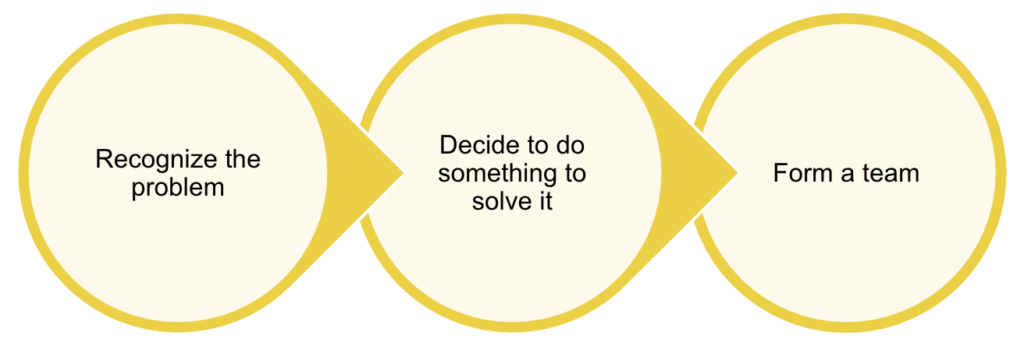
Develop the research questions
- The PAR team then developed a set of research questions that they posed to students, parents, and staff during focus-group discussions and in an online survey.
- A significant percentage of the school’s student, staff, and family population was ultimately involved in the process as a leadership-team member, focus-group facilitator, or study participant.
This action represents the 4th stage of PAR, that was presented previously.

Data Analysis
- When Sample High School’s students, families, educators, and administrators came together to analyze and interpret the PAR data, each group gained a new understanding of the problem—and of each other.
- It also became apparent that several simple adjustments could be made to existing discipline policies and practices, that would improve interactions between students and educators.
- As these improvements were implemented, the PAR team continued to collect and study discipline data, while educating themselves about alternative disciplinary practices that had been effective in other schools.
These actions represent the 5th stage of PAR, that was presented previously.
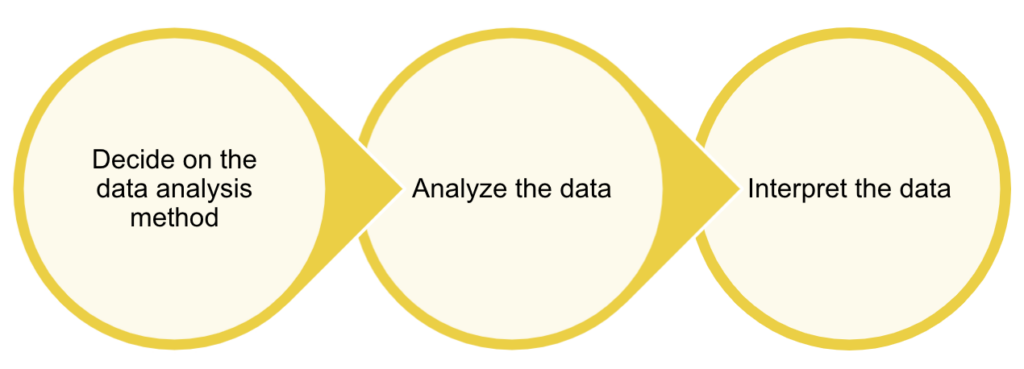
- Because Sample High School’s PAR data indicated that policy changes alone were unlikely to eliminate the problems that were identified during the focus-group conversations and survey, the PAR Team decided to follow a cyclical process of observation, reflection, action, evaluation and modification.
- Over time, the school introduced:
- policy modifications,
- a new staff training program, and
- alternative disciplinary practices,
which resulted in a year-over-year decrease in behavioral problems and disciplinary referrals.
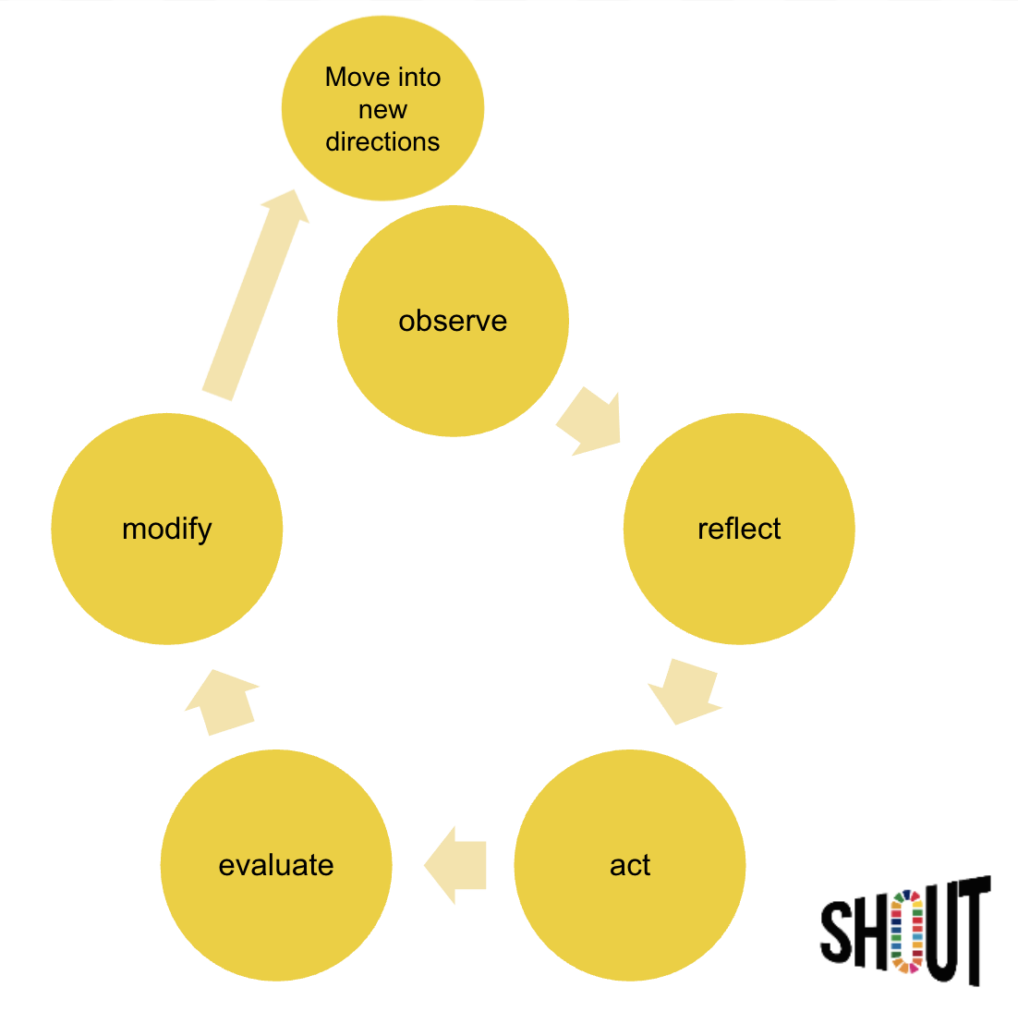
During the PAR team’s focus groups, Sample High School’s administrators and educators were surprised, and occasionally even shocked, by what they learned from participants:
- They realized
- that the home lives of their students and families were far more difficult than they had assumed;
- that behavioral problems often began with stressful situations outside of school;
- that teachers didn’t have training or clear guidance on how to manage behavioral problems productively; and
- that many parents were looking for strategies to reduce the stress their children were experiencing inside and outside of school.
- School leaders:
- began to see that policies and practices designed to control student behavior, rather than show respect and compassion, were contributing to the problem
- realized that they did not have the capacity or expertise to address some of the problems identified during the focus groups, and
- realized that they needed to enlist assistance from other organizations and agencies.
Benefits of the research process
They were able to connect disciplinary issues in the school to broader social issues related to policing, mass incarceration, racism and poverty.
The members of the PAR team decided to become more involved in their school and community. In fact, two members decided to run for open school-board seats in the next election cycle.
The school decided to enact policies and practices that countered—rather than exacerbated—broader social forces.
They gained new research, facilitation, reflection, and data-analysis skills. They were also motivated to share what they learned during school-board meetings and community forums, which led them to the acquisition of new skills and confidence as advocates, presenters and public speakers.
Case study: Observations from the field
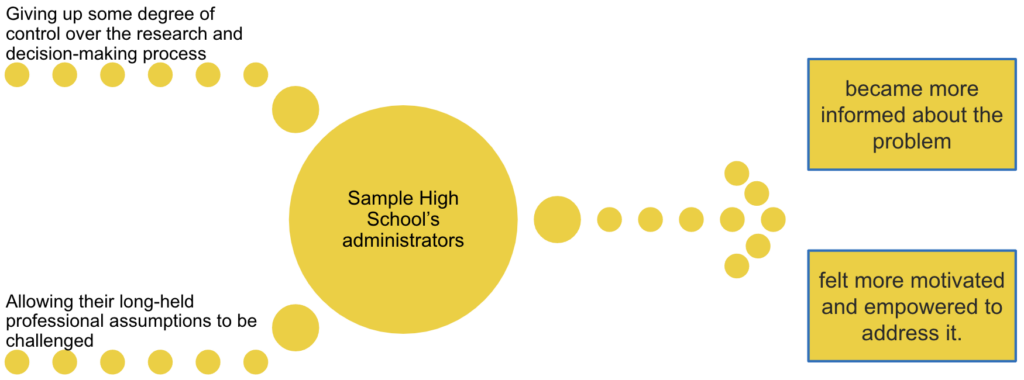
Although administrators felt uncomfortable and defensive at first, PAR process resulted in a much clearer understanding of their students and families, which helped the administrative team build stronger and more meaningful relationships with their community that also led to positive changes in other school policies, programs, and practices.
Although the conversations were emotionally difficult for everyone involved at times, PAR process ultimately helped administrators, teachers, students and families learn how to be more honest and vulnerable with one another.
